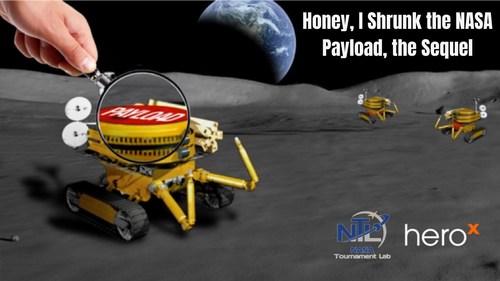Winners to Share $140K Prize Purse for Creating Novel, Miniaturized Lunar Payloads in Preparation for Sustained Presence on the Moon
HeroX, the leading platform and open marketplace for crowdsourced solutions, today announced the winners of the "Honey, I Shrunk the NASA Payload, the Sequel" Challenge. The Challenge sought designs for miniature payload prototypes that could be sent to the Moon to help fill gaps in lunar knowledge.

Winners to Share $140K Prize Purse for Creating Novel, Miniaturized Lunar Payloads in Preparation for Sustained Presence on the Moon
The first "Honey, I Shrunk the NASA Payload Challenge" launched on April 9, 2020. Fourteen teams were recognized and rewarded for their innovative approaches to miniature payload development. These fourteen teams were invited to participate in the sequel challenge, which launched on October 15, 2020. From among those fourteen teams, four finalist teams were selected who then relied on crowdsourcing to recruit new team members and fill any resource gaps they might have. Two of these expanded teams completed the next step of the challenge and were each awarded up to $225,000 that was used to develop their proposals into functioning, flight-ready payloads. In addition, a third team was awarded $65,000 to develop their proposal. Two years later, these teams have completed their hardware development and testing, and could one day see their payloads operate on the Moon.
The first, second and third place teams will now receive $100,000, $25,000, and $15,000, respectively, in prize money from HeroX, but all three finalist teams are also being evaluated by NASA for potential accommodation on a future flight to the Moon.
First place winner, Sunslicer - Miniaturized XRAY Spectrometer by Team Sun Slicer
Team SunSlicer is a collection of space and space science enthusiasts with founding members Phillip Jobson, Garrett Jernigan, John Doty and Brian Silverman. Garrett, John and Brian are MIT alumni that have co-developed cubesats for educational purposes. Brian Silverman built and mentored the 3-man software team which included Vadim Gerasimov (Scientist, Google Software Engineer and co-developer of the original TETRIS Game) who performed the invaluable heavy lifting for the payload firmware implementation, BLDC motor controller and user interface development. Phil Jobson led the SunSlicer project and was responsible for all aspects of the payload project management, hardware development, implementation, procurement and testing.
SunSlicer is an innovative, miniature, low power, versatile, TRL7 flight ready XRAY spectrometer with custom packaging and thermal design to adapt it for a harsh, miniature rover-deployed lunar environment. A key feature of SunSlicer is the lunar dust mitigation concept that utilizes a rotary shutter/filter wheel and wiper system that is driven by an extremely compact custom motor implementation and geartrain. SunSlicer has many impactful mission possibilities for the Artemis program in both identifying lunar resource potential and characterizing the lunar environment including prospecting for rock forming elements leveraging solar flares, measuring flare producing solar active regions to high angular accuracy and monitoring background XRAY radiation.
Second place winner, Puli Lunar Water Snooper by Puli Space Technologies
The Puli Lunar Water Snooper is a neutron spectrometer that detects hydrogen atoms in lunar regolith. Hydrogen concentrations indicate whether water and other hydrogen bearing volatiles are present. Since these neutrons are generated by cosmic rays, hydrogen can be detected several meters below the surface. A low-cost, simple, and extremely lightweight solution for this capability is critical for future robotic explorations on the Moon.
Puli Space Technologies is also helping explore the rough lunar terrains & harsh lunar environment with an experienced team of engineers and scientists passionate about the Moon http://pulispace.com
Third place winner, µRAD, A Micro-Scale Lunar Radiation Detector by Christian Haughwout and Thomas (Joey) Murphy.
µRAD is proposed by a two-person team composed of Christian Haughwout and Thomas (Joey) Murphy. Christian and Joey are graduate students at MIT pursuing PhDs in space systems engineering in the department of aeronautics and astronautics.
Radiation is one of the greatest threats to extended human habitation in space. Shielding from and mitigating the effects of this radiation for the Artemis program will require detailed surveys of the radiation environment at the lunar pole. Currently existing devices capable of making the required measurements are too large and too expensive for widespread deployment on Commercial Lunar Payload Services (CLPS) rovers and landers.
Therefore, Team µRAD's payload is a miniaturized radiation measuring instrument with many of the same features as the radiation assessment detector (RAD) on the Curiosity rover, but whose size, weight, and power (SWaP) are compatible with smaller exploration vehicles.
To view the challenge, visit https://www.herox.com/NASAPayload2
ABOUT HEROX
HeroX is a platform and open marketplace for crowdsourcing innovation and human ingenuity, co-founded in 2013 by serial entrepreneur, Christian Cotichini and XPRIZE Founder and Futurist, Peter Diamandis. HeroX offers a turnkey, easy-to-use platform that supports anyone, anywhere, to solve everyday business and world challenges using the power of the crowd. Uniquely positioned as the Social Network for Innovation, HeroX is the only place you can build, grow and curate your very own crowd.
Explore the latest challenges at www.herox.com
Media Contact:
Alexandra Pony
250.858.0656
press@herox.com
SOURCE HeroX
